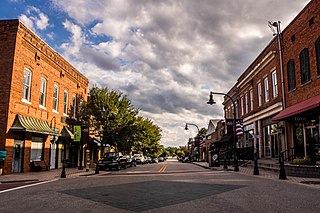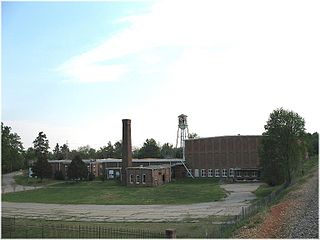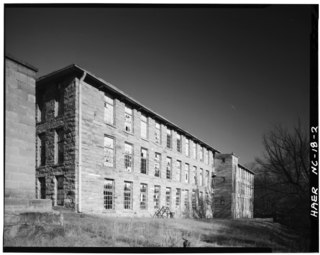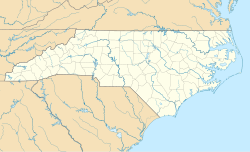
Wake Forest is a town in Wake and Franklin counties in the U.S. state of North Carolina. Located almost entirely in Wake County, it lies just north of the state capital, Raleigh. At the 2020 census, the population was 47,601, up from 30,117 in 2010. It is part of the Raleigh metropolitan area. Wake Forest was the original home of Wake Forest University for 122 years before it moved to Winston-Salem in 1956.

Fries is an incorporated town located on the New River in Grayson County, Virginia, 15.5 miles northeast of the county seat in Independence — in Virginia's Blue Ridge Highlands and on Virginia's musical heritage trail, The Crooked Road.

Cannelton Cotton Mill, also known as Indiana Cotton Mill, is a National Historic Landmark of the United States located in Cannelton, Indiana, United States. Built in 1849 as an effort to expand textile milling out of New England, it was the largest industrial building west of the Allegheny Mountains, designed by Thomas Alexander Tefft, an early industrial architect. It was declared a National Historic Landmark in 1991. The building now houses residences.

Falls, is an unincorporated community in Wake County, North Carolina, United States, situated on Old Falls of Neuse Road, between Raleigh and Wake Forest, near the Wakefield Plantation development. Falls Dam, on the Neuse River, is within the community.

The Nashua Manufacturing Company Historic District in Nashua, New Hampshire, is a historic district that was listed on the National Register of Historic Places (NRHP) in 1987. It encompasses an area just west of downtown Nashua, roughly located along the southern bank of the Nashua River, bordered on the west side by Mine Falls Park, on the south side by the Nashua River canal, up to Ledge Street, and from the east side by Factory, Pine and Water streets, up to the Main Street bridge.

Historic Oak View, also known as the Williams-Wyatt-Poole Farm, is a 19th-century historic farmstead and national historic district located east of downtown Raleigh, North Carolina, United States. Founded as a forced-labor farm worked by black people enslaved by the land's white owners, Oak View features an early 19th-century kitchen, 1855 farmhouse, livestock barn, cotton gin barn, and tenant house dating to the early 20th century. The Farm History Center located on site provides information to visitors regarding the history of the Oak View and the general history of farming in North Carolina. Aside from the historic buildings, the site also features an orchard, a honey bee hive, a small cotton field, and the largest pecan grove in Wake County.
Dunavant Cotton Manufacturing Company, also known as Alpine Cotton Mill No. 1, is a historic cotton mill located at Morganton, Burke County, North Carolina. It is a two-story, brick-clad, side gable-roofed building. The original section was built in 1888–1910, with additions and expansions through 1966. The additions to the building, made in the mid to late 1960s were removed in 2012 to reveal the original 1888-1910 mill building. It is the oldest cotton textile mill in Morganton, and was in use as a cotton textile mill until 1949.

Hudson Cotton Manufacturing Company, also known as Shuford Mills, is a historic textile mill located at Hudson, Caldwell County, North Carolina. It was built in stages between 1904 and 1992, and is a large, one-story, brick building of nearly 180,000 square feet. It features a three-stage, square, brick tower built as part of the original, 1904, construction.

Erwin Cotton Mills Company Mill No. 1 Headquarters Building, also known as Erwin Square, is a historic textile mill complex located at Durham, Durham County, North Carolina. The mill was built in 1892, and is a two-story, 748 feet long, brick building. It features three square towers projecting from the east facade and hundreds of large and closely spaced windows. The building exemplifies "slow burn" construction with its exterior load bearing brick walls and its heavy timber heart pine beams and columns. The headquarters building is a Late Victorian style brick building built in 1892 and enlarged in 1896 and 1905. Attached to the headquarters building is a warehouse. In 1983–1984, the complex was renovated as offices and apartments.

West Durham Historic District is a national historic district located at Durham, Durham County, North Carolina. The district encompasses 101 contributing buildings in a mixed industrial, commercial, and residential section of Durham. The buildings primarily date after 1892 and include notable examples of Classical Revival, Italianate, and Queen Anne architecture. Located in the district is the separately listed Erwin Cotton Mills Company Mill No. 1 Headquarters Building. Other notable buildings include Erwin Cotton Mills Co. Mill No. 4 (1909–10), Erwin Cotton Mills Co. worker's housing (1910s), Fidelity Bank (1920s), E. K. Powe School (1928), Blacknall Memorial Presbyterian Church (1923), and St. Joseph's Episcopal Church.

Sterling Cotton Mill, also known as the Franklinton Cotton Mill, is a historic cotton mill complex located at 108-112 East Green Street in Franklinton, Franklin County, North Carolina. The main mill is a one and two-story L-shaped brick building with Industrial Italianate style design elements. The mill consists of five sections: the original gabled one-story section rising to a two-story section at the east end (1895); a two-story addition (1914), a one-story addition (1960s); pre-1926 "cotton sheds"; and a small two-story brick office (1966). Associated with the mill is the contributing detached chimney stack. The mill was built by Samuel C. Vann, whose son Aldridge built the Aldridge H. Vann House. The mill closed in 1991.

Revolution Cotton Mills, also known as Revolution Division and Cone Mills, is a historic cotton mill complex located at Greensboro, Guilford County, North Carolina. The complex was built between 1900 and the mid-20th century and is an example of "slow burning construction." It includes 12 contributing buildings and 2 contributing structures. They include the main mill building, warehouses, weave room and machine shop, bleachery and dye room, storage/shipping/office building, and yellow brick chimney stack. The mill ceased operation in February 1982. As of 2024, the 45-acre complex includes 800,000 square feet of space with office, residential and retail development and event space. 140 businesses and nonprofits have located in the building, and 20 percent of its 184 apartments are considered affordable.

Capitola Manufacturing Company Cotton Yarn Mill, also known as the Marshall Mill and Power Company, is a historic cotton mill complex located at Marshall, Madison County, North Carolina. The main mill building is a three-story brick building built about 1905. It was raised to three stories in 1928. It measures approximately 108 feet (33 m) by 116 feet (35 m), with a low-pitched gabled roof, and windows on three sides. Also on the property is a contributing boiler house and water tank.

Former Nebel Knitting Mill is a historic textile mill building located at Charlotte, Mecklenburg County, North Carolina. It was designed by noted mill architect Richard C. Biberstein and built in 1927 and expanded in 1929. It is a two-story, reinforced concrete building with a brick veneer and decorative concrete detailing with Art Moderne detailing. The building has a rectangular plan measuring 204 feet across the facade and 182 feet deep. The 1927 portion has a stepped-parapet roofline with concrete coping, while the mill's 1929 part has concrete coping and a simple, crenelated roofline.
Savona Mill, also known as Savona Manufacturing Company, Alfred Cotton Mill, and Old Dominion Box Company, is a historic textile mill located at Charlotte, Mecklenburg County, North Carolina. The building consists of four sections, three of which are historic. They are the 1915-1916 Weave Mill, a one-story rectangular brick building with segmental arched head windows, a low gable roof with exposed beam ends and a wood clerestory monitor roof; the 1921 Spinning Mill, a three-story rectangular brick building with large rectangular steel windows; and the 1951 three-story Paper Warehouse addition. The Weave Mill was designed by Lockwood, Greene & Co.; Richard C. Biberstein designed the Spinning Mill.

Roxboro Cotton Mill is a historic cotton mill complex located at Roxboro, Person County, North Carolina. It was built in 1899, and is a two-story, banked, textile mill with Italianate-style influence and slow-burning heavy timber frame construction covered by common bond brickwork. An addition to the original mill building was built in 1924, and together they measure approximately 525 feet long. The building housed the spinning and carding operations. The mill remained in operation until 1999.

Falls of the Neuse Manufacturing Company, also known as the Manteo Manufacturing Company and Forest Manufacturing Company, is a historic paper mill complex located at Falls, Wake County, North Carolina. The main mill building was built from1854–1855, and is a three-story, quarried granite block building measuring 195 feet long and 54 feet wide. Located on the property is the stone mill dam, measuring about 400 feet wide and roughly 6 feet tall, and the one-story picker room, measuring 53 feet square. The mill operated as a paper mill until 1896, and later housed a cotton mill and warehouse.
Wake Forest Historic District is a national historic district located at Wake Forest, Wake County, North Carolina. The district encompasses 245 contributing buildings, one contributing site, and five contributing structures built between about 1890 and 1953 and located in the historic core of the town of Wake Forest. It includes notable examples of Greek Revival and Federal style architecture. Located in the district are the separately listed Lea Laboratory, South Brick House, and the Powell-White House, a contributing resource in the Glen Royall Mill Village Historic District. Other notable buildings include the historic campus of Wake Forest College, Wake Forest Baptist Church (1913), Magnolia Hill (1928), Calvin Jones House, John M. Brewer House, Wait-Taylor House (1843), Taylor-Purefoy-Poteat-Swett House, Community House, St. Catherine of Siena Catholic Church, the Powers Store (1897), and former Water and Light Building (1909).
Glen Royall Mill Village Historic District is a historic mill town and national historic district located at Wake Forest, Wake County, North Carolina. The district encompasses 82 contributing buildings and 1 contributing site built between about 1900 and 1949. It is located in a residential section of the town of Wake Forest. There are notable examples of Bungalow / American Craftsman style architecture. Located in the district is the separately listed Royall Cotton Mill Commissary. Other notable buildings include the Royall Cotton Mill (1899-1900), the Powell-White House (1909-1910), and pyramidal cottages, triple-A cottages, and shotgun houses.
Wakefield Dairy Complex is a historic commercial building associated with the Royall Mill and located at Wake Forest, Wake County, North Carolina. The complex was built in 1934, and consists of an 8,000 square foot, four-story, dairy barn with silos; a bull barn; and a calf barn. It was built to house John Sprunt Hill's Guernsey dairy herd.


















